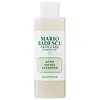What's inside
What's inside
 Key Ingredients
Key Ingredients

 Benefits
Benefits

 Concerns
Concerns

 Ingredients Side-by-side
Ingredients Side-by-side

Myristic Acid
CleansingGlycerin
HumectantBehenic Acid
CleansingPalmitic Acid
EmollientSodium Methyl Cocoyl Taurate
CleansingPotassium Hydroxide
BufferingLauric Acid
CleansingStearic Acid
CleansingAlgae Extract
EmollientSesamum Indicum Seed Oil
EmollientMedicago Sativa Seed Powder
Skin ConditioningHelianthus Annuus Seedcake
AbrasivePrunus Amygdalus Dulcis Seed Meal
AbrasiveEucalyptus Globulus Leaf Oil
PerfumingSodium Gluconate
Skin ConditioningCopper Gluconate
Skin ConditioningCalcium Gluconate
HumectantMagnesium Gluconate
Skin ConditioningZinc Gluconate
Skin ConditioningTocopheryl Succinate
AntioxidantNiacin
SmoothingSesamum Indicum Seed Powder
Skin ConditioningQuartz Powder
AbrasiveNephrite Powder
AbrasivePearl Powder
Caffeine
Skin ConditioningMaris Sal
Skin ConditioningHumic Acids
Skin ConditioningSodium Hyaluronate
HumectantSucrose
HumectantTourmaline
Macrocystis Pyrifera Protein
Skin ConditioningPolyquaternium-51
Skin ConditioningAloe Barbadensis Leaf Water
MaskingTrehalose
HumectantCellulose
AbsorbentButylene Glycol
HumectantSodium Coco Pg-Dimonium Chloride Phosphate
CleansingSodium Bicarbonate
AbrasiveSodium PCA
HumectantPEG-3 Distearate
EmulsifyingUrea
BufferingParfum
MaskingDisodium EDTA
Linalool
PerfumingLimonene
PerfumingPhenoxyethanol
PreservativeMethylchloroisothiazolinone
PreservativeMethylisothiazolinone
PreservativeCI 19140
Cosmetic ColorantCI 15985
Cosmetic ColorantCI 42090
Cosmetic ColorantCI 61570
Cosmetic ColorantMyristic Acid, Glycerin, Behenic Acid, Palmitic Acid, Sodium Methyl Cocoyl Taurate, Potassium Hydroxide, Lauric Acid, Stearic Acid, Algae Extract, Sesamum Indicum Seed Oil, Medicago Sativa Seed Powder, Helianthus Annuus Seedcake, Prunus Amygdalus Dulcis Seed Meal, Eucalyptus Globulus Leaf Oil, Sodium Gluconate, Copper Gluconate, Calcium Gluconate, Magnesium Gluconate, Zinc Gluconate, Tocopheryl Succinate, Niacin, Sesamum Indicum Seed Powder, Quartz Powder, Nephrite Powder, Pearl Powder, Caffeine, Maris Sal, Humic Acids, Sodium Hyaluronate, Sucrose, Tourmaline, Macrocystis Pyrifera Protein, Polyquaternium-51, Aloe Barbadensis Leaf Water, Trehalose, Cellulose, Butylene Glycol, Sodium Coco Pg-Dimonium Chloride Phosphate, Sodium Bicarbonate, Sodium PCA, PEG-3 Distearate, Urea, Parfum, Disodium EDTA, Linalool, Limonene, Phenoxyethanol, Methylchloroisothiazolinone, Methylisothiazolinone, CI 19140, CI 15985, CI 42090, CI 61570
Water
Skin ConditioningGlycerin
HumectantTriethanolamine
BufferingSodium Laureth Sulfate
CleansingPropylene Glycol
HumectantIsopropyl Alcohol
SolventSalicylic Acid
MaskingDimethicone
EmollientAloe Barbadensis Leaf Juice
Skin ConditioningChamomilla Recutita Flower Extract
MaskingThymus Vulgaris Leaf Extract
Skin ProtectingSodium Hyaluronate
HumectantCarbomer
Emulsion StabilisingParfum
MaskingDiazolidinyl Urea
PreservativeMethylparaben
PreservativePropylparaben
PreservativeBenzyl Benzoate
AntimicrobialBenzyl Salicylate
PerfumingEugenol
PerfumingLinalool
PerfumingWater, Glycerin, Triethanolamine, Sodium Laureth Sulfate, Propylene Glycol, Isopropyl Alcohol, Salicylic Acid, Dimethicone, Aloe Barbadensis Leaf Juice, Chamomilla Recutita Flower Extract, Thymus Vulgaris Leaf Extract, Sodium Hyaluronate, Carbomer, Parfum, Diazolidinyl Urea, Methylparaben, Propylparaben, Benzyl Benzoate, Benzyl Salicylate, Eugenol, Linalool
 Reviews
Reviews

Ingredients Explained
These ingredients are found in both products.
Ingredients higher up in an ingredient list are typically present in a larger amount.
Glycerin is already naturally found in your skin. It helps moisturize and protect your skin.
A study from 2016 found glycerin to be more effective as a humectant than AHAs and hyaluronic acid.
As a humectant, it helps the skin stay hydrated by pulling moisture to your skin. The low molecular weight of glycerin allows it to pull moisture into the deeper layers of your skin.
Hydrated skin improves your skin barrier; Your skin barrier helps protect against irritants and bacteria.
Glycerin has also been found to have antimicrobial and antiviral properties. Due to these properties, glycerin is often used in wound and burn treatments.
In cosmetics, glycerin is usually derived from plants such as soybean or palm. However, it can also be sourced from animals, such as tallow or animal fat.
This ingredient is organic, colorless, odorless, and non-toxic.
Glycerin is the name for this ingredient in American English. British English uses Glycerol/Glycerine.
Learn more about GlycerinLinalool is a fragrance and helps add scent to products. It's derived from common plants such as cinnamon, mint, citrus, and lavender.
Like Limonene, this ingredient oxidizes when exposed to air. Oxidized linalool can cause allergies and skin sensitivity.
This ingredient has a scent that is floral, spicy tropical, and citrus-like.
Learn more about LinaloolParfum is a catch-all term for an ingredient or more that is used to give a scent to products.
Also called "fragrance", this ingredient can be a blend of hundreds of chemicals or plant oils. This means every product with "fragrance" or "parfum" in the ingredients list is a different mixture.
For instance, Habanolide is a proprietary trade name for a specific aroma chemical. When used as a fragrance ingredient in cosmetics, most aroma chemicals fall under the broad labeling category of “FRAGRANCE” or “PARFUM” according to EU and US regulations.
The term 'parfum' or 'fragrance' is not regulated in many countries. In many cases, it is up to the brand to define this term.
For instance, many brands choose to label themselves as "fragrance-free" because they are not using synthetic fragrances. However, their products may still contain ingredients such as essential oils that are considered a fragrance by INCI standards.
One example is Calendula flower extract. Calendula is an essential oil that still imparts a scent or 'fragrance'.
Depending on the blend, the ingredients in the mixture can cause allergies and sensitivities on the skin. Some ingredients that are known EU allergens include linalool and citronellol.
Parfum can also be used to mask or cover an unpleasant scent.
The bottom line is: not all fragrances/parfum/ingredients are created equally. If you are worried about fragrances, we recommend taking a closer look at an ingredient. And of course, we always recommend speaking with a professional.
Learn more about ParfumSodium Hyaluronate is hyaluronic acid's salt form. It is commonly derived from the sodium salt of hyaluronic acid.
Like hyaluronic acid, it is great at holding water and acts as a humectant. This makes it a great skin hydrating ingredient.
Sodium Hyaluronate is naturally occurring in our bodies and is mostly found in eye fluid and joints.
These are some other common types of Hyaluronic Acid:
Learn more about Sodium Hyaluronate